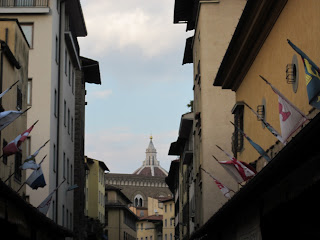It is an "old bridge", indeed! The bridge that you see today has been in place since 1345, after the bridge that was there had been swept away in a flood. Actually, there had been several bridges there over the centuries, all of which were swept away by flood waters.
The bridge is known for the many shops built onto the sides of the bridge.
Above the shops, you can see the Vasari Corridor, which was built in 1565 upon orders from Cosimo I de Medici to connect Palazzo Vecchio with Palazzo Pitti. This corridor allowed the Grand Duke, his family, and staff to travel from one palace to the other without having to walk among the townspeople.
 |
| The Vasari Corridor, seen above the shops |
When the bridge first opened, the shops on the bridge were filled with butchers. Unfortunately for the butchers, in 1593, the Grand Duke prohibited them from occupying the shops on the Ponte Vecchio, due to the fact that his royal nose was offended by the smells as he traveled from one of his palaces to the other. After the butchers left, the goldsmiths took their place and remain there to this day.
 |
| Gold filled jewelry shops lining the ponte |
Walking across the bridge, you will probably notice that the presence of the gold merchants gives the bridge an interesting brilliance. The large windows displaying their wares give off a warm golden glow as the light reflects off of all of the gold.
In the center of the bridge, on the eastern side, there is an opening between shops that houses a bust of Benvenuto Cellini, noted goldsmith and artist from the 16th century. Oftentimes, you can find a street musician performing in front of the bust, as you can see in the picture above. The singer that we happened upon, like most street performers in Florence, was quite good! He was a bit more high-tech than most we saw, though, with his sound system hooked up to a car battery!
If you happen to peer over the side of the bridge, near the bust of Cellini, you will probably notice a lot of padlocks that were placed there by lovers. Look closely and you'll notice that the locks have initials or names written on them. Tradition dictates that attaching a lock to the bridge and tossing the key into the river will ensure that the couple have an eternal bond. Nice for the lovers, but not so great for the bridge keepers! This tradition is a fairly new one and caused trouble for the city, having to remove thousands of padlocks on a routine basis. Padlocks are still found on the bridge, but not as many as before, thanks in part to the hefty 50 euro fine that is handed out if you're caught placing a lock on the bridge.
 |
| Padlocks attached to the bridge by daring lovers |
The Ponte Vecchio is another site in Florence that's a must-see. It's definitely unique, and if you happen to have a wad of cash that you'd like to trade for some jewelry, then by all means, this is the bridge for you! The bridge is free to walk across, though, so buy a gelato, enjoy the stroll, the views from the bridge, and do a little window shopping if you don't have money to burn. Looking is free, after all!
 |
| The top of the Duomo, peeking over the top of buildings, as seen while crossing the Ponte Vecchio. |


No comments:
Post a Comment